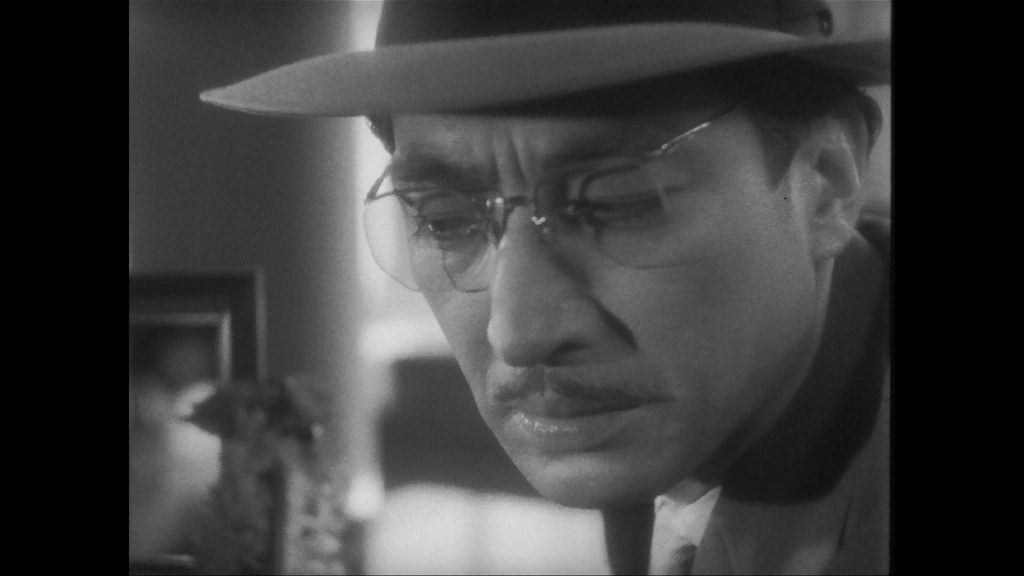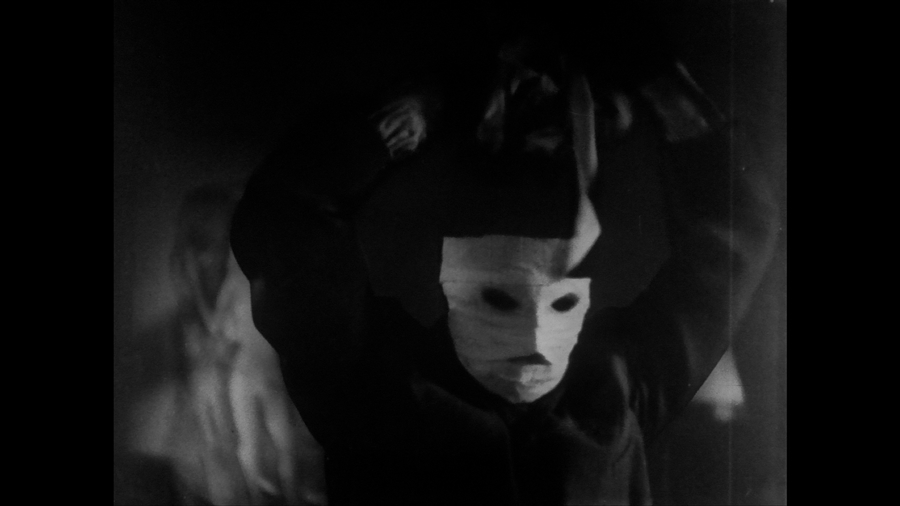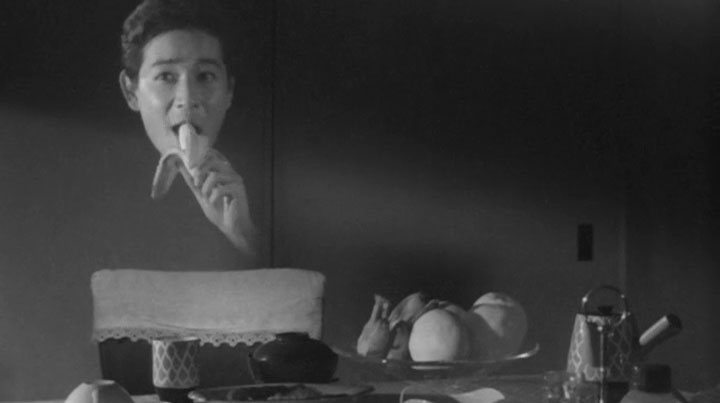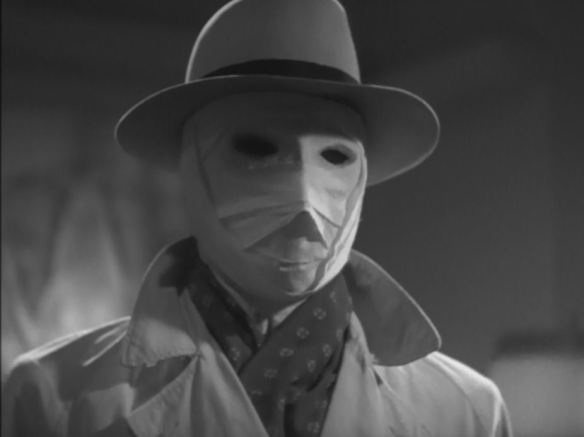Finally released outside Japan for the very first time, these unique riffs on H.G. Wells’ classic character (though undoubtedly also indebted to Universal’s iconic film series) are two of the earliest examples of tokusatsu (special effects) cinema from the legendary Daiei Studios. In The Invisible Man Appears, written and directed by Nobuo Adachi in 1949, a scientist successfully creates an invisibility serum, only to be kidnapped by a gang of thugs who wish to use the formula to rob a priceless jewel. In addition to being the earliest surviving Japanese science fiction film ever made, the film’s entertaining special effects were an early credit for the legendary Eiji Tsuburaya, five years before he first brought Godzilla to life. Eight years later, Mitsuo Murayama’s exciting The Invisible Man vs. The Human Fly tells the story of a series of mysterious murders where the only clue is a strange buzzing noise at the scene of the crime… could this be linked to secret wartime experiments in shrinking humans to the size of insects? And can a scientist who’s just invented an invisibility ray be the one to stop it?

The Invisible Man Appears (1949)
Jewel thieves become interested in an invisibility formula invented by Professor Nakazato and want to use his invention to acquire a diamond necklace called the “Tears of Amour.”
The Invisible Man Appears is a film where it is imperative not to overthink the logistics of what is going on throughout the narrative. When comparing it to previous American versions of The Invisible Man, this one most closely relates to some of the later sequels that moved more away from the horrific aspects of the tale and more into the crime territory. This particular narrative has several moving parts that we are introduced to in rapid succession. Professor Nakazato (Ryūnosuke Tsukigata) is the employer and mentor of two ambitious scientists, Segi (Daijirō Natsukawa) and Kurokawa (Kanji Koshiba), who both happen to be vying for the affection of his daughter, Machiko (Chizuru Kitagawa). The two young scientists have differing theories on a potential “invisibility” potion, but what they do not know is that their professor has already mostly cracked the code and created a version himself – he just can’t make them visible again and it makes the subject go insane. When Nakazato happens to share his work with crooked businessman Kawabe (Shosaku Sugiyama), the shady figure gets some money-making ideas in his head.
This movie is a lot of cheesy fun, but admittedly the plot is threadbare at best. The movie goes out of its way to set up convenient scenarios so that characters come into contact with one another and, ultimately, an irresistible treasure. When Kawabe sets about a grand plan that involves kidnapping and forced servitude involving the invisibility potion, you are struck by the narrowness of his ambition. This bad guy goes through the effort of forcing a man to become invisible to carry out his deeds, and all he wants to do is steal one particular necklace – out of all the easy targets in the world. Not only that, but the Invisible Man has a tendency to botch what should be an easy heist at every turn in a way that is almost comical. The film also goes out of its way to try to hide the identity of who the Invisible Man is for the longest time, but they paint a picture so obvious that you wonder why they are being so unnecessarily mysterious.
It might sound like I’m ragging on this picture, but I poke fun at it with love. It is patently ridiculous most of the time, but it is quite a bit of fun if you want a robbery tale with a creative twist. The romantic triangle hinted at above does not amount to much in the end thanks to the poor depiction of Machiko, but the film does have some fun with another female character that is given much more agency. Kurokawa’s sister Ryuko (Takiko Mizunoe) is an androgynous entertainer with a short haircut who dresses in men’s attire. She is also one of the smarter, more capable people in the entire picture as she actually makes decent strides towards fixing the entire situation near the end. The true fun of the picture, though, is the filmmaking techniques on display to show off the invisibility. Eiji Tsuburaya helps pull off some visually interesting techniques that you want out of this type of film such as the removal of clothes from a hidden figure. This film has a lighthearted tone about it that should appeal to those who are ready to go along for this crazy heist picture. While technology has evolved significantly since this period, you need to embrace the scrappy charms of past filmmaking for all corners of the world.

The Invisible Man Vs. The Human Fly (1957)
A ruthless serial killer with a peculiar method of stalking and killing his victims comes face to face with a police officer turned invisible by a scientific experiment. Who will emerge triumphant?
Nearly a decade later and this next attempt at an Invisible Man tale tries to replicate the success Americans were having pitting two monstrous figures against one another. While it would be natural to think The Human Fly of the title would have some connection to the classic film The Fly, this film actually preceded that one with the creative team drawing from the popularity of The Incredible Shrinking Man. The “fly” in this picture is actually just a contract killer who has a concoction that can make him the size of a fly – and obviously anything that would be so small could naturally float. For a good portion of this film, the creative team once again takes you on a long journey to the truth of what is going down that involves a lot of people getting murdered in a very similar manner over and over until someone throws out a random guess as to what is actually going on. Tiny hitmen are cool with me, but the repetitive nature of this first half gets to be a bit much.
The other major problem with this particular tale is that the titular Invisible Man is not introduced into the story until halfway through, at which point you are left with one question: why would invisibility be an advantage to stopping a human fly? It is best not to think too much about this answer, because the movie certainly does not. As with the previous film, it is best not to think too hard about the logistics of this film. What you can properly ding this feature for is the lack of utilization of the Invisible Man throughout the film. You come to an Invisible Man film to “see” him, but he only shows up in fits and spurts with not much to do or to show off for the audience. It is left up to the Human Fly to make things interesting by going full super villain and upping his game to killing off hundreds of people at a time in massive bombings as part of a public ransom demand. The plot is convoluted and not as satisfying as The Invisible Man Appears. The film also pads its runtime unnecessarily with cabaret numbers and other strange detours. In the end, this feature provides some ridiculous fun, but it will strain the patience of those who expect more from a classic sci-fi flick.

Video Quality
The Invisible Man Appears + The Invisible Man vs. The Human Fly come to Blu-Ray courtesy of Arrow Video sourced from high definition masters in the original 1.37:1. Before going into general impressions of the transfer, it is best to let Arrow explain the state of these elements:
The Invisible Man Appears and The Invisible Man vs. The Human Fly are presented from the best surviving film elements, which in both cases are 16mm exhibition prints. As a result, both transfers feature anomalies like picture weaving, scratches and exposed film edges that we felt could not be effectively repaired without further compromising the integrity of the original image.
We sincerely hope these issues do not affect your enjoyment of these two rare pieces of tokusatsu history, available outside Japan for the first time.
While it would be easy to break each of these down individually, the quality is fairly uniform across the board and there would be a lot of repeating thoughts. The black-and-white photography looks decent in high definition, but the company was not lying when it said that there were some major issues with these transfers. Lots of damage and pretty frequent wobbling throughout. The problems are much more noticeable on The Invisible Man Appears, but both transfers have their fair share of issues. The contrast is well defined, but there is an obvious amount of print damage found in these presentations. There is some detail present with subtle textures on the costumes and in the production design. Black levels are appropriately not very deep with blacks leaning more towards gray. The quality of these transfers are as strong as the source material will allow. They are not pretty, but the win is having these films available in the first place looking the best they can under the circumstances.
Audio Quality
This Blu-Ray comes with LPCM 1.0 mono tracks in the original Japanese (with optional English subtitles). Dialogue sounds pretty clear without sound effects or the score trouncing on important information. As with the video section, The Invisible Man vs. The Human Fly fairs better than its predecessor, but both are doing the best with what is available to them. Damage does not prove to be as big of an issue as the video portion, but the audio can sound pretty harsh or overly bright at points. The menacing score comes through nicely in relation to the competing sounds. This is not a particularly dynamic presentation, but it presents everything accurately without too many unwanted issues not tied to the source material.

Special Features
The first-pressing of the Arrow Video Blu-Ray of The Invisible Man Appears + The Invisible Man vs. The Human Fly includes a booklet featuring the essay “Invisible Man In Japan” by writer Keith Allison. This piece provides great context to the character of The Invisible Man in Japanese culture in these two Daiei films along with one misguided Toho entry not on this disc. The booklet also includes the essay “Invisible Men: Ghosts of the Post-War Era” by writer Hayley Scanlon concerning the place of these films in post-war Japanese cinema, and the piece “Eiji Tsuburaya” by Tom Vincent, which explores the career of the special effects master behind this film. The on-disc special features are as follows:
- Transparent Terrors: A 25-minute featurette in which film historian Kim Newman provides a joyous and thoughtful exploration of the “Invisible Man” subgenre. Not only does Neman discuss various adaptations of the story, but he delves into some of the recurring themes and techniques along with the way in which these films seemed like they were poised to set up a franchise of “invisible men” fighting various figures. This is an interesting piece that is well worth checking out for fans of the genre.
- The Invisible Man Appears Theatrical Trailer: The two-and-a-half minute trailer is provided here which plays up the technical achievement of the film. The trailer is in really rough shape, but makes for an interesting relic.
- Image Galleries: A collection of production and promotional photos are provided for each film.
Final Thoughts
The Invisible Man Appears and The Invisible Man vs. The Human Fly are very rare features that are finally getting a chance to have a life outside of Japan. Admittedly, they are not undiscovered classics, but they have a quaint, old-school charm about them that will bring joy to a certain type of viewer. The Invisible Man is a character that has had many lives, so it can be quite fascinating to see how other countries utilized his distinct traits. Arrow Video has provided a Blu-Ray sporting an A/V presentation that is as strong as the material will allow along with a couple of interesting special features. If you know yourself to be a fan of this genre, this is worth an investment of your time and money. Recommended
The Invisible Man Appears + The Invisible Man vs. The Human Fly is currently available to purchase on Blu-Ray.
Note: Images presented in this review are not reflective of the image quality of the Blu-Ray.
Disclaimer: Arrow Video has supplied a copy of this disc free of charge for review purposes. All opinions in this review are the honest reactions of the author.

Dillon is most comfortable sitting around in a theatre all day watching both big budget and independent movies.







